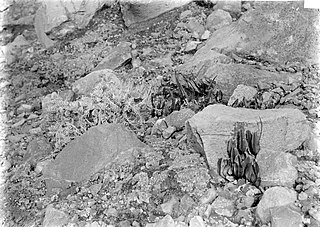
Bergenia is a genus of ten species of flowering plants in the family Saxifragaceae, native to central Asia, from Afghanistan to China and the Himalayan region.

Catechin is a flavan-3-ol, a type of secondary metabolite providing antioxidant roles in plants. It belongs to the subgroup of polyphenols called flavonoids.
Thearubigins are polymeric polyphenols that are formed during the enzymatic oxidation and condensation of two gallocatechins with the participation of polyphenol oxidases during the fermentation reactions in black tea. Thearubigins are red in colour and are responsible for much of the staining effect of tea. Therefore, a black tea often appears red while a green or white tea has a much clearer appearance. The colour of a black tea, however, is affected by many other factors as well, such as the amount of theaflavins, another oxidized form of polyphenols.
In enzymology, a leucoanthocyanidin reductase (EC 1.17.1.3) (LAR, aka leucocyanidin reductase or LCR) is an enzyme that catalyzes the chemical reaction

The phenolic content in wine refers to the phenolic compounds—natural phenol and polyphenols—in wine, which include a large group of several hundred chemical compounds that affect the taste, color and mouthfeel of wine. These compounds include phenolic acids, stilbenoids, flavonols, dihydroflavonols, anthocyanins, flavanol monomers (catechins) and flavanol polymers (proanthocyanidins). This large group of natural phenols can be broadly separated into two categories, flavonoids and non-flavonoids. Flavonoids include the anthocyanins and tannins which contribute to the color and mouthfeel of the wine. The non-flavonoids include the stilbenoids such as resveratrol and phenolic acids such as benzoic, caffeic and cinnamic acids.

Taxifolin (5,7,3',4'-flavan-on-ol), also known as dihydroquercetin, belongs to the subclass flavanonols in the flavonoids, which in turn is a class of polyphenols.

Procyanidin C2 is a B type proanthocyanidin trimer, a type of condensed tannin.
A type proanthocyanidins are a specific type of proanthocyanidins, which are a class of flavonoid. Proanthocyanidins fall under a wide range of names in the nutritional and scientific vernacular, including oligomeric proanthocyanidins, flavonoids, polyphenols, condensed tannins, and OPCs. Proanthocyanidins were first popularized by French scientist Jacques Masquelier.

Selliguea feei is a fern belonging to the genus Selliguea in the family Polypodiaceae. This fern can be collected in Indonesia. The species name feei commemorates the botanist Antoine Laurent Apollinaire Fée.

Syringetin is an O-methylated flavonol, a type of flavonoid. It is found in red grape, in Lysimachia congestiflora and in Vaccinium uliginosum. It is one of the phenolic compounds present in wine.

Quercetagetin is a flavonol, a type of flavonoid. It can be found in the genus Eriocaulon.

Procyanidin C1 (PCC1) is a B type proanthocyanidin. It is an epicatechin trimer found in grape, unripe apples, and cinnamon.

Bergenin, alias cuscutin, is trihydroxybenzoic acid glycoside. It is the C-glycoside of 4-O-methyl gallic acid. It possesses an O-demethylated derivative called norbergenin. These are chemical compounds and drugs of Ayurveda, commonly known as Paashaanbhed. It shows a potent immunomodulatory effect.

In biochemistry, naturally occurring phenols are natural products containing at least one phenol functional group. Phenolic compounds are produced by plants and microorganisms. Organisms sometimes synthesize phenolic compounds in response to ecological pressures such as pathogen and insect attack, UV radiation and wounding. As they are present in food consumed in human diets and in plants used in traditional medicine of several cultures, their role in human health and disease is a subject of research. Some phenols are germicidal and are used in formulating disinfectants.

Cucurbitane is a class of chemical compounds with formula C
30H
54. It is a polycyclic hydrocarbon, specifically triterpene. It is also an isomer of lanostane, from which it differs by the formal shift of a methyl group from the 10 to the 9β position in the standard steroid numbering scheme.

The pomegranate ellagitannins, which include punicalagin isomers, are ellagitannins found in the sarcotestas, rind (peel), bark or heartwood of pomegranates.
B type proanthocyanidins are a specific type of proanthocyanidin, which are a class of flavanoids. They are oligomers of flavan-3-ols.

Kaempferol-3-O-rutinoside is a bitter-tasting flavonol glycoside. It can be isolated from the rhizomes of the fern Selliguea feei.

Catechin-7-O-glucoside is a flavan-3-ol glycoside formed from catechin.
Arthromeris mairei is a fern species in the genus Arthromeris.


















